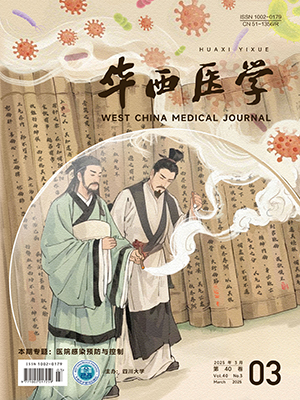| 1. |
Singer M, Deutschman CS, Seymour CW, et al. The third international consensus definitions for sepsis and septic shock (Sepsis-3). JAMA, 2016, 315(8): 801-810.
|
| 2. |
Ma S, Evans RG, Iguchi N, et al. Sepsis-induced acute kidney injury: a disease of the microcirculation. Microcirculation, 2019, 26(2): e12483.
|
| 3. |
Pickkers P, Darmon M, Hoste E, et al. Acute kidney injury in the critically ill: an updated review on pathophysiology and management. Intensive Care Med, 2021, 47(8): 835-850.
|
| 4. |
Poston JT, Koyner JL. Sepsis associated acute kidney injury. BMJ, 2019, 364: k4891.
|
| 5. |
Manrique-Caballero CL, Del Rio-Pertuz G, Gomez H. Sepsis-associated acute kidney injury. Crit Care Clin, 2021, 37(2): 279-301.
|
| 6. |
Evans L, Rhodes A, Alhazzani W, et al. Surviving sepsis campaign: international guidelines for management of sepsis and septic shock 2021. Intensive Care Med, 2021, 47(11): 1181-1247.
|
| 7. |
Ronco C, Chawla L, Husain-Syed F, et al. Rationale for sequential extracorporeal therapy (SET) in sepsis. Crit Care, 2023, 27(1): 50.
|
| 8. |
Ziegler I, Cajander S, Rasmussen G, et al. High nuc DNA load in whole blood is associated with sepsis, mortality and immune dysregulation in Staphylococcus aureus bacteraemia. Infect Dis (Lond), 2019, 51(3): 216-226.
|
| 9. |
Gavelli F, Castello LM, Avanzi GC. Management of sepsis and septic shock in the emergency department. Intern Emerg Med, 2021, 16(6): 1649-1661.
|
| 10. |
Seffer MT, Eden G, Engelmann S, et al. Elimination of Staphylococcus aureus from the bloodstream using a novel biomimetic sorbent haemoperfusion device. BMJ Case Rep, 2020, 13(8): e235262.
|
| 11. |
Chen L, Kraft BD, Roggli VL, et al. Heparin-based blood purification attenuates organ injury in baboons with Streptococcus pneumoniae pneumonia. Am J Physiol Lung Cell Mol Physiol, 2021, 321(2): L321-L335.
|
| 12. |
Seffer MT, Cottam D, Forni LG, et al. Heparin 2.0: a new approach to the infection crisis. Blood Purif, 2021, 50(1): 28-34.
|
| 13. |
Chitty SA, Mobbs S, Rifkin BS, et al. A multicenter evaluation of the seraph 100 microbind affinity blood filter for the treatment of severe COVID-19. Crit Care Explor, 2022, 4(4): e0662.
|
| 14. |
Chelakkot C, Ghim J, Ryu SH. Mechanisms regulating intestinal barrier integrity and its pathological implications. Exp Mol Med, 2018, 50(8): 1-9.
|
| 15. |
Fujimori K, Tarasawa K, Fushimi K. Effects of polymyxin B hemoperfusion on septic shock patients requiring noradrenaline: analysis of a nationwide administrative database in Japan. Blood Purif, 2021, 50(4/5): 560-565.
|
| 16. |
Fujimori K, Tarasawa K, Fushimi K. Effectiveness of polymyxin B hemoperfusion for sepsis depends on the baseline SOFA score: a nationwide observational study. Ann Intensive Care, 2021, 11(1): 141.
|
| 17. |
Payen DM, Guilhot J, Launey Y, et al. Early use of polymyxin B hemoperfusion in patients with septic shock due to peritonitis: a multicenter randomized control trial. Intensive Care Med, 2015, 41(6): 975-984.
|
| 18. |
Dellinger RP, Bagshaw SM, Antonelli M, et al. Effect of targeted polymyxin b hemoperfusion on 28-day mortality in patients with septic shock and elevated endotoxin level: the EUPHRATES randomized clinical trial. JAMA, 2018, 320(14): 1455-1463.
|
| 19. |
Monard C, Rimmelé T, Ronco C. Extracorporeal blood purification therapies for sepsis. Blood Purif, 2019, 47(Suppl 3): 1-14.
|
| 20. |
Zhang L, Cove M, Nguyen BG, et al. Adsorptive hemofiltration for sepsis management: expert recommendations based on the Asia Pacific experience. Chin Med J (Engl), 2021, 134(18): 2258-2260.
|
| 21. |
Peng Z, Singbartl K, Simon P, et al. Blood purification in sepsis: a new paradigm. Contrib Nephrol, 2010, 165: 322-328.
|
| 22. |
Srisawat N, Tungsanga S, Lumlertgul N, et al. The effect of polymyxin B hemoperfusion on modulation of human leukocyte antigen DR in severe sepsis patients. Crit Care, 2018, 22(1): 279.
|
| 23. |
Scharf C, Schroeder I, Paal M, et al. Can the cytokine adsorber CytoSorb® help to mitigate cytokine storm and reduce mortality in critically ill patients? A propensity score matching analysis. Ann Intensive Care, 2021, 11(1): 115.
|
| 24. |
Huang Z, Wang SR, Su W, et al. Removal of humoral mediators and the effect on the survival of septic patients by hemoperfusion with neutral microporous resin column. Ther Apher Dial, 2010, 14(6): 596-602.
|
| 25. |
Huang Z, Wang SR, Yang ZL, et al. Effect on extrapulmonary sepsis-induced acute lung injury by hemoperfusion with neutral microporous resin column. Ther Apher Dial, 2013, 17(4): 454-461.
|





 Baidu Scholar
Baidu Scholar